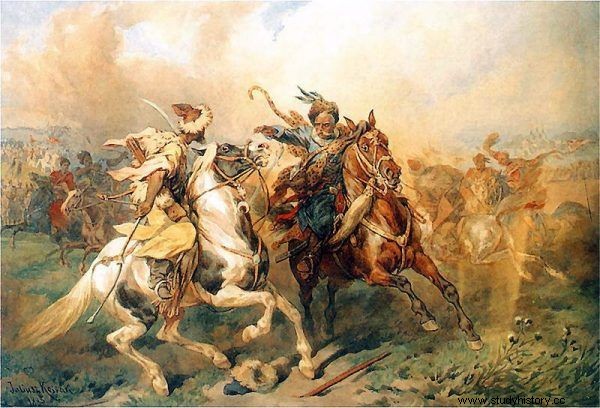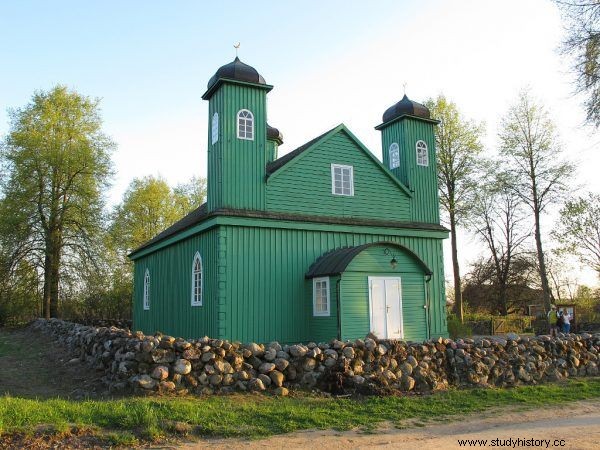Is Asia Tuhajbejowicz, known from the "Trilogy" and the TV screen, only a figment of Henryk Sienkiewicz's imagination? Not completely. Although the prototype of the cruel traitor did not have a "bluish color on the pierced breast", his biography was equally interesting.
Book Asia becomes the leader of the Lipków rebellion, i.e. Tatars living in the Polish-Lithuanian Commonwealth and serving in its army. At the same time, he is the son of the famous Crimean commander Tugai Bey, kidnapped and raised by a Polish nobleman. In his actions, he is guided mainly by the desire for glory, honor and revenge over his Polish "guardian", who did not spare him a whip, and by love for Barbara Wołodyjowska.

Daniel Olbrychski as Asia Tuhajbejowicz in "Pan Wołodyjowski".
In fact, Aleksander Kryczyński was at the head of the Tatar banners that passed to the Turkish side at the turn of 1671 and 1672, mentioned in Sienkiewicz's novel as one of the rebel colonels. His ancestors settled in Lithuania at the beginning of the 15th century, and in the 1720s they moved to Wołyń. And how much did Kryczyński really have in common with Asia Tuhajbejowicz?

Aleksander Kryczyński has taken part in such a dance more than once. Not always on the same side ... (painting by Juliusz Kossak, public domain).
From the hero…
They were both distinguished soldiers. From 1654 Kryczyński served in the Crown Army as a captain of his own Tatar banner. He fought in Ukraine against the Khmelnytsky insurgents, and in 1655 against the Moscow invasion. In the battle of Gródek he saved Stanisław Rewera Potocki from the death of the Grand Hetman of the Crown , "Knocked off Moskvitzin's horse" - as a witness of these events wrote.
In the following years, Kryczyński fought with the Swedes under the command of Stefan Czarniecki, and in 1660 with the Moskwicins and Cossacks near Cudnow and Słobodyszcz, where he was badly wounded. In 1665 and 1666 he fought against the rebels of Lubomirski, and in 1667 and 1671 against the Tatar invasions. Between subsequent wars he fought fierce disputes with his neighbors in Volhynia:once in a courtroom, and once with a saber in hand and with the help of Tatar subordinates.
… to the traitor
There were many reasons for the Lipków rebellion. In 1667, the Seym ignored their merits and refused to pay them overdue pay. Later, too, they did not receive payment for faithful service. The number of their banners was drastically reduced, depriving some of the soldiers of occupation. In addition, the construction and renovation of mosques was forbidden, which was particularly acute in the Crown, where the Tatar settlement intensified only after 1655.
The king promised to grant the hereditary ownership of the village of Ceceniowce in Volhynia to Kryczyński himself, but the Seym did not agree to it. In this situation it is hardly surprising that when it became clear that in 1672 there would be a Polish-Turkish war, the zealous Muslim Kryczyński decided to go to the side of the Sultan and drew many other Tatar banners with him .

Mosque in Kruszyniany in Podlasie, one of the villages given to Lipki by Sobieski after their return to the service of the Republic of Poland (photo:Krzysztof Kundzicz, CC BY-SA 3.0).
At the same time, neither Raszków nor any other borderland housing estate was burnt down. The Lipka family simply left their winter lair and joined the enemy camp with their families. There were from two to four thousand of them. It is worth emphasizing that the Lithuanian Tatars remained faithful to the Republic of Poland, their banners fought on the Polish side, among others in the battle of Khotyn.
Honors, jealousy and death
The Lipkos knew the battlefield very well, so they rendered invaluable services to the Turks, especially as scouts, guides and interpreters. They often clashed in skirmishes with their former comrades-in-arms and ruthlessly plundered the population of Ruthenian lands. As the nineteenth-century historian Julian Bartoszewicz wrote, "In their clothes, in their speech, you wouldn't know them that the Tatars wore Polish." They used it more than once, pretending to be Polish banners and surprising the inhabitants of the villages and towns they attacked.
Kryczyński, after his initial successes, grew more and more feathers. He founded his own harem, and in July 1673 he was appointed by the Sultan's nomination to be a fortress in Bar. His career was open to him, but his increasing position made other Tatar captain's envy. Polonized and accustomed to almost noble liberties, the Lipkos quickly became disappointed with Turkish care. On October 13, 1673, as Polish troops were approaching Bar, a group of supporters of returning to Polish banners cornered and murdered their superior.
The leader of the Lipków family did not die impaled, like Asia, with his only eye drilled with a drill bit, but quite simply, pierced with a spear. The Lipka family soon received an amnesty and served again in the Polish army, remaining faithful to the Polish-Lithuanian Commonwealth until the end of its existence.
